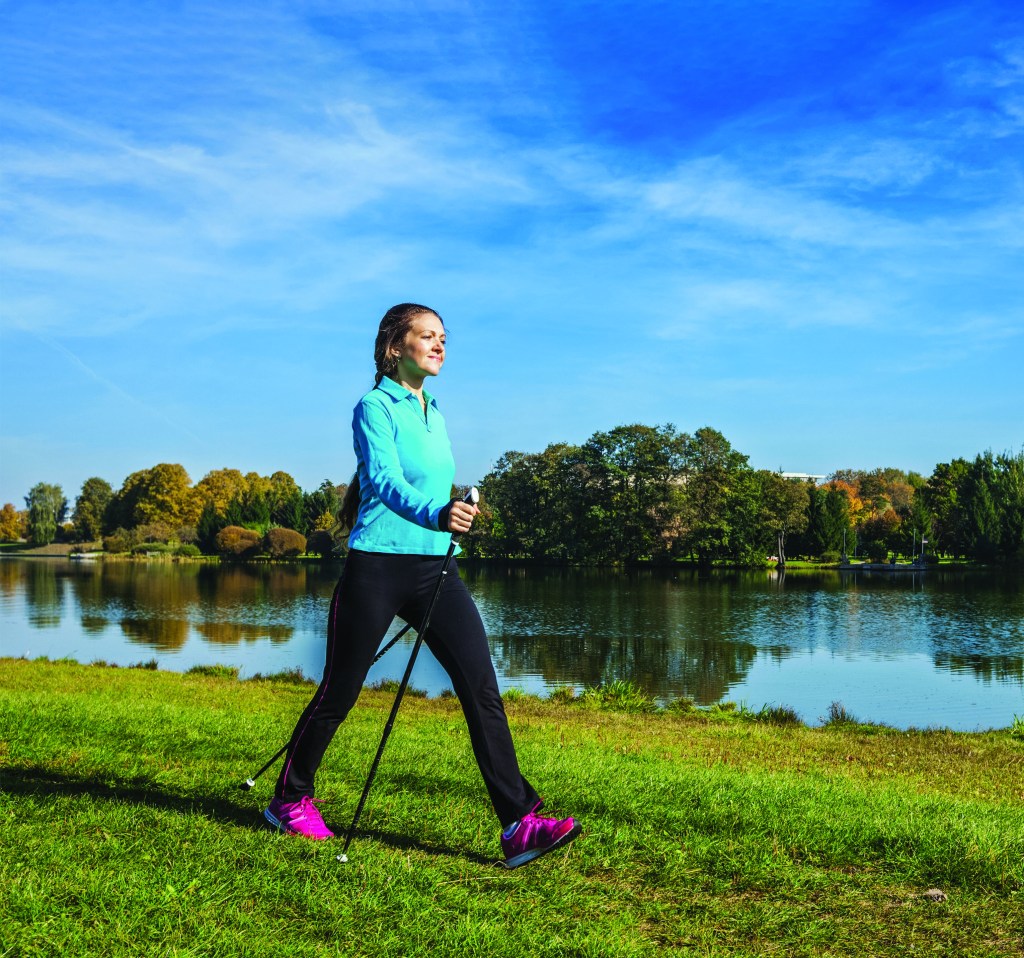From speed walking to rucking, learn how to up the ante on your daily walking workout with this expert advice from the brains behind National Walking Month
Walking has so many benefits, yet it’s often overlooked as a form of exercise. Regular brisk walking helps maintain a healthy weight, lowers your risk of heart disease, type 2 diabetes, certain cancers and depression. In fact, studies have shown that moderate-intensity walking provides the same health benefits as more intense workouts, such as running. This is more important than ever, when so many of us struggle to fit regular exercise into our busy schedules.
‘Because of the health benefits of walking and wheeling [using a wheelchair], and its ability to connect us with friends and family, walking can improve not only our own wellbeing but also that of those around us. Plus, walking and wheeling are free and you can do them anywhere,’ says Catherine Woodhead, chief executive of Living Streets (livingstreets.org.uk), the UK charity for everyday walking.
Living Streets hosts National Walking Month every May to highlight the magic of walking. It campaigns to make Britain’s streets safer and more welcoming places to walk, from improving routes to schools to pushing for lower speed limits where people live, work and play.
Turn walks into workouts
It might require some habit changes, but walking can be a part of daily life. Chances are you’re already visiting multiple places in a day, such as taking a hild to nursery or school, visiting an older relative, commuting to work, picking up ingredients for dinner, and maybe even heading to the gym and back. If you can swap one or more of your car trips for a walk, it can make a substantial difference to your health. Try timing a walk you do regularly, for example to work, and then work on cutting down your time a little more each day. Once you’re walking a faster mile, you can increase the distance. A brisk-paced walk can burn up to 370 calories per hour, and walking is proven to make us feel calmer and happier, so turning your walk into a workout makes perfect sense. Walking more also helps reduce congestion and air pollution.
Step up your stroll
Interval training
‘If you are ready to take things to the next level but are time-poor, interval walking is a great option for boosting your endurance and burning more calories,’ says Dr Jo Maher, a GP and expert in walking for fitness.
As the name describes, it involves intervals of more intense bursts of power walking before returning to an easy pace. Interval training is perfect to do with a friend, dog or even an energetic child.
‘Start at an easy walking pace, so you could still hold a conversation. Then, after five minutes, go ‘all out’ and power walk until you’re out of breath. Repeat. That’s it! Begin by doing interval walking for 20 minutes or less, and build it up,’ says Dr Maher.
As well as being a fun way to get fit, there is scientific evidence to support an interval approach to exercise, whether you’re working out at the gym or on a walk. Between 30 seconds to two minutes of vigorous activity is enough to turbo charge our muscles and metabolism into action.
Speed walking workout
Vigorous activity such as a speed or power walk is another terrific way to boost your fitness and energy levels. The NHS says just 75 minutes of vigorous activity per week is equal to 150 minutes of moderate activity. Just like with interval walking, power walking gives health benefits when you’re rushed for time.
Is there is a walk you do most days and you’re always in a hurry – a school pick-up or commute home in time for dinner? ‘In less than 20 minutes you can cover about a mile, so a speed walk is perfect for short journeys.
‘Try listening to a great audiobook or favourite podcast and walking as fast as you can. You might be surprised at how quickly you can reach your destination!’ says Woodhead.

Stroll your way to fitness with a walking workout
Rucking
Rucking is the new strength training trend you can do on the school run. It’s a vigorous walk with extra weight added onto your body, in a rucksack or backpack. This added weight is the key to turning an everyday walk into one which improves muscle strength, power and endurance.
It has been known for a long time that resistance training is important for good health at any age. ‘Strength training at least twice a week will help keep our muscles, bones and joints strong as you age. That can include walking carrying a heavy weight,’ explains Dr Maher, who is also a physical activity clinical champion (movingmedicine.ac.uk/about-pacc). ‘As you get older, you can easily lose muscle strength, which can then impact your independence and mobility – it’s a case of use it or lose it. After the age of 40, this process can accelerate, leading to a more severe form of muscle wasting called sarcopenia in older age.
‘Sarcopenia is characterised by feeling weak, having falls and struggling with everyday activities such as getting out of a chair unaided. Try rucking on your next walk and see how you feel.’
Nordic walking workout
You’ve probably seen them in your local park – the groups of fit older people walking briskly with long poles, snow and Scandinavians optional. There’s a reason why it’s so popular with older people, Nordic walking is an excellent workout that supports balance and builds endurance.
‘If you have a pre-existing health condition or are recovering from an injury, Nordic walking can help get you back to good health. Evidence shows this approach can be particularly helpful for people with long-term conditions such as Parkinson’s disease or circulation problems,’ explains Dr Maher.
Nordic walking poles don’t look like conventional walking sticks, they are longer, straight with a hand grip and fabric hook to go around the wrist. You can certainly tackle mountains with them, but whether you are a stroller or a strider, walking in this style can help keep you fit and provide the mental health benefits of getting outside.








